Underground Space Utilization in the Urban Land-Use Planning of Casablanca (Morocco)
Abstract
1. Introduction
2. Integration of Underground Space in the Urban Land-Use Planning Processes
3. Review of Examples of Underground Space Integration in Urban Land-Use Planning in Europe
3.1. Glasgow Case
3.1.1. Issues of Underground Space in Glasgow
3.1.2. Integration of Underground Space in Glasgow’s Urban Planning
3.2. Hamburg Case
3.2.1. Issues of Urban Underground Space in Hamburg
3.2.2. Integration of Underground Space in Hamburg’s Urban Planning
3.3. Helsinki Case
3.3.1. Issues of Urban Underground Space in Helsinki
3.3.2. Integration of Underground Space in Helsinki’s Urban Planning
4. Components and Resources of Urban Underground Spaces
4.1. Usages of Underground Space Resource Families
4.1.1. The Use of Underground Land
4.1.2. The Use of Groundwater
- The urban distribution network, which is the main network that generally carries most of the drinking water resources;
- Alternative networks, which develop when water resources are limited; and
- Spot captures for individual users (industry, households, etc.).
4.1.3. The Use of Geothermal Energy
- Deep geothermal energy: The geothermal flow is operated by open systems at a depth that exceeds 5 km and at a temperature above 100 °C to produce electricity and heat.
- Medium-depth geothermal energy: the exploitation of the geothermal flow is done with an open system to produce heat at depths of 2–2.5 km and temperatures ranging from 60 to 80 °C. Exploitation tests for medium-depth geothermal energy are inconclusive. The exploitation can be done just at lower depths (thermal waters) in case of the presence of a thermal anomaly or from the tunnel drainage water.
- Shallow geothermal energy: Between 0 and 250 m and at temperatures between 10 and 20 °C. The thermal capacity of the subsurface is used to produce heat and cold for air conditioning. A heat pump is coupled with the structures.
4.1.4. The Use of Geomaterials
- Mineral building materials, such as concrete and asphalt aggregates; and
- Backfill materials for road and rail infrastructure, excavation work, and site alterations.
4.2. Interactions of the Uses of Urban Underground Space Resources
5. Modeling of Underground Space Resources and Their Integration into Urban Land-Use Planning
5.1. Three-Dimensional (3D) Urban Geological Models
- Layer modeling: It is the creation of a set of surfaces representing generally stratigraphic geological changes and other elements, such as faults. It is the most used, although it has limitations because of the creation time of the model and the difficulty of illustrating several lithologies [32]. For example, the Dutch spatial planning model has three conceptual layers, namely the occupancy layer with buildings and other major land-use functions, the network layer representing the transport and utility infrastructure networks, and the underground layer with underground constructions, such as tunnels and mines [5].
- Stochastic modeling: This approach uses geostatistical techniques to determine the probabilities of some properties, such as lithology or hydraulic connectivity in 3D spaces. To do this, a 3D grid, in which the simulation can be fulfilled, must be created.
5.2. Models of Artificial Land
6. Usage and Modeling of Underground Space in Casablanca
6.1. Presentation of the Study Area (Casablanca)
6.1.1. Geographic and Socio-Economic Context
6.1.2. Horizontal Sprawl of the Urban Planning in Casablanca
6.2. Urban Underground Space of Casablanca
6.2.1. Geological Context
6.2.2. Resources of the Underground Space
- Ground land: The first works in the subsoil of Casablanca were conducted for the construction of the port’s quay in 1907 and then its extension in 1913 [50,51]. Low interest was given to the use of the subsoil with the exception of a few tunnels for networks or transportation or a few buildings for storage (cellar, parking). The urban expansion was horizontal and did not consider the waste of valuable land above the surface. The construction of an underground structure depends on the geological and hydrogeological conditions and the urban context in which the infrastructure fits. In practice, the evaluation of the technologies and the means to be implemented to carry out the project is performed by professionals on the basis of geotechnical and geological studies that present the quantitative parameters (direction of dip, mechanical parameters, permeability, etc.) and the qualitative parameters (particle size heterogeneity, heterogeneity of geological formations, etc.) and also on the basis of their expertise.
- Groundwater: The infiltrated rainwater accumulates or transits into groundwater reservoirs. The study area has two water tables and some streams, as shown in Figure 6. The first is the water table of the coastal Chaouia, which extends over 1.200 km² of the coastal strip and is 20 km wide. It is characterized by very low piezometric levels, varying between 8 and 20 m, medium to low permeability over its entire extent, and flows per structure generally not exceeding 4 L/s. It has a potential of 52 million m3 [44]. Of a heterogeneous nature, it is contained at once in the calcareous formations of the plio-quaternary, in the Cenomanian marnocalcaries, and in the primary schistose, sandstone, and quartzitic terrains [52].
- Geomaterials: The development of mining activities is favored by a varied geological structure and its concentration in ores. The mineral potential of the Casablanca region, including the study area, is limited, and it is restricted to antimony, salt, and iron. However, the extraction and exploitation of certain ores is stalled because of their low economic return [44]. As for the extraction of stone and aggregates, many quarries began at several points in the plio-pleistocene marine and dune formations consolidated into storied cords [55].
6.3. Underground Space Uses in Casablanca
6.3.1. Subway Project: An Example of Failure
6.3.2. Underground Super Collector Project: An Example of Success
6.4. Proposal for an Integrated Model of Urban Underground Space Use in Casablanca
6.4.1. Planning and Management of Urban Land-Use Planning in Casablanca
6.4.2. Towards a Model Integrating the Underground Space in Urban Land-Use Planning
7. Conclusions
Author Contributions
Funding
Acknowledgments
Conflicts of Interest
References
- Chow, F.C.; Paul, T.; Vähäaho, I.T.; Sellberg, B.; Lemos, L.J.L. Hidden Aspects of Urban Planning: Utilisation of Underground Space. In Proceedings of the 2nd International Conference on Soil Structure Interaction in Urban Civil Engineering, Zurich, Switzerland, 7–8 March 2002; pp. 1–7. [Google Scholar]
- Admiraal, H.; Cornaro, A. Why underground space should be included in urban planning policy—And how this will enhance an urban underground future. Tunn. Undergr. Space Technol. 2016, 55, 214–220. [Google Scholar] [CrossRef]
- Gogu, C.R.; Gaitanaru, D.; Boukhemacha, M.A.; Serpescu, I.; Litescu, L.; Zaharia, V.; Mihailovici, M.J. Urban hydrogeology studies in Bucharest City, Romania. Procedia Eng. 2017, 209, 135–142. [Google Scholar] [CrossRef]
- Jamalludin, N.A.; Zaini, F.; Hussin, K. Development of Underground Land in Malaysia: The Need for Master Plan of Urban Underground Land Development. Procedia-Soc. Behav. Sci. 2016, 219, 394–400. [Google Scholar] [CrossRef]
- Van Der Meulen, M.J.; Diarmad, S.; Campbell, G.; Lawrence, D.J.; Lois Gonzalez, R.C.; Van Campenhout, I.P.A.M. Out of Sight Out of Mind? Considering the Subsurface in Urban Planning—State of the Art; COST TU1206 Sub-Urban Report TU1206-WG1-001; NGU (Geological Survey of Norway): Trondheim, Norway, 2016. [Google Scholar]
- Ronka, K. Underground space in land-use planning. Tunn. Undergr. Space Technol. 1998, 13, 39–49. [Google Scholar] [CrossRef]
- Zaini, F.B.; Hussin, K.B.; Arrifin, A.B.; Ali, N.B. The Future Use of Underground Space in Malaysia: A Literature Review. Int. J. Estate Stud. 2012, 7, 16–27. Available online: https://www.researchgate.net/publication/261667011 (accessed on 9 November 2018).
- United Nations. Post-2015 Sustainable Development Agenda; United Nations Development Program: New York, NY, USA, 2015; Available online: http://www.undp.org/content/undp/en/home/mdgoverview/post-2015-development-agenda.html (accessed on 9 November 2018).
- Pratesi, F.; Tapete, D.; Del Ventisette, C.; Moretti, S. Mapping interactions between geology, subsurface resource exploitation and urban development in transforming cities using InSAR Persistent Scatterers: Two decades of change in Florence, Italy. Appl. Geogr. 2016, 77, 20–37. [Google Scholar] [CrossRef]
- Ndaw, M.F. Study on valuing the potential of ICT in the water sector, Sanitation and Hygiene. Summary of Conclusions and Recommendations; Public Disclosure Authorized Ouagadougou 01. Burkina Faso, 2015. Available online: http://documents.worldbank.org/curated/en/838971468188667235/pdf/100297-WSP-FRENCH-Box393228B-PUBLIC.pdf (accessed on 9 November 2018).
- De Pas, A. The BRGM abroad: Geosciences at the service of the States, Press file. BRGM Geosci. Sustain. Land 2016, 1–7. Available online: http://www.brgm.fr/sites/default/files/dossier_presse_brgm_igc2016.pdf (accessed on 9 November 2018).
- Vahaaho, I. Underground resources and master plan in Helsinki. Adv. Undergr. Space Dev. 2013, 1528–1539. [Google Scholar] [CrossRef]
- Seither, A.; Ganerød, G.V.; De Beer, H.; Melle, T.; Eriksson, I. Bergen; COST TU1206 Sub-Urban Report WG1-003; NGU (Geological Survey of Norway): Trondheim, Norway, 2016. [Google Scholar]
- Hooimeijer, F.L.; Lafleur, F.; Trinh, T.T. Drawing the subsurface: An integrative design approach. Procedia Eng. 2017, 209, 61–74. [Google Scholar] [CrossRef]
- Bartel, S.; Janssen, G. Underground spatial planning—Perspectives and current research in Germany. Tunn. Undergr. Space Technol. 2016, 55, 112–117. [Google Scholar] [CrossRef]
- Money, S.; Gap, T.H.E.; Reus, T. Sub-Urban Planning Pathways & Pitfalls to Better; COST Action TU1206 Sub-Urban; NGU (Geological Survey of Norway): Trondheim, Norway, 2016; ISBN 9788273852014. [Google Scholar]
- Lois González, R.C.; Ulloa, B.M.; Otón, M.P. The underground of European cities in planning documents: The case of A Coruña (Spain). Procedia Eng. 2017, 209, 42–48. [Google Scholar] [CrossRef]
- Whitbread, K.; Dick, G.; Campbell, D. Glasgow; COST TU1206 Sub-Urban Report TU1206-WG1-005; NGU (Geological Survey of Norway): Trondheim, Norway, 2016. [Google Scholar]
- Schokker, J.; Sandersen, P.; De Beer, H.; Eriksson, I.; Kallio, H.; Kearsey, T.; Pfleiderer, S.; Seither, A. 3D Urban Subsurface Modelling and Visualization; TU1206 COST Sub-Urban WG2.3-004 Report; NGU (Geological Survey of Norway): Trondheim, Norway, 2017. [Google Scholar]
- Bonsor, H.C.; Dahlqvist, P.; Moosmann, L.; Classen, N.; Epting, J.; Huggenberger, P.; Garica-Gil, A.; Janźa, M.; Laursen, G.; Stuurman, R.; et al. Groundwater Geothermal Modelling and Monitoring at City-Scale. Reviewing European Practice and Knowledge Exchange; COST Sub-Urban Report TU1206-WG2.4-005; NGU (Geological Survey of Norway): Trondheim, Norway, 2017. [Google Scholar]
- Campbell, D.; De Beer, J.; Mielby, S.; Van Campenhout, I.; Van Der Meulen, M.; Erikkson, I.; Ganerodb, G.; Lawrencea, D.; Bacicg, M.; Donaldh, A.; et al. Transforming The Relationships Between Geoscientists and Urban Decision-Makers: European Cost Sub-Urban Action (TU1206). Procedia Eng. 2017, 209, 4–11. [Google Scholar] [CrossRef]
- Taugs, R.; Moosmann, L.; Classen, N.; Meyer, P. Hamburg; COST TU1206 Sub-Urban Report TU1206-WG1-006; NGU (Geological Survey of Norway): Trondheim, Norway, 2016. [Google Scholar]
- Ikävalko, O.; Satola, I.; Hoivanen, R. Helsinki; COST TU1206 Sub-Urban Report TU1206-WG1-007; NGU (Geological Survey of Norway): Trondheim, Norway, 2016. [Google Scholar]
- ISOCARP. Think Deep: Planning, Development and Use of Underground Space in Cities; ISOCARP: Pijnacker, The Netherlands, 2015; ISBN 978-94-90354-34-3. [Google Scholar]
- Li, X.Z.; Li, C.; Parriaux, A.; Liu, C. Multiple resources and their sustainable development in Urban Underground Space. Tunn. Undergr. Space Technol. 2016, 55, 59–66. [Google Scholar] [CrossRef]
- Kishii, T. Utilization of underground space in Japan. Tunn. Undergr. Space Technol. 2016, 55, 320–323. [Google Scholar] [CrossRef]
- Li, H. An Integrated Strategy for Sustainable Underground Urbanization. Ph.D. Thesis, Federal Institute of Technology, Lausanne, Switzerland, 2013. [Google Scholar]
- Attard, G.; Rossier, Y.; Winiarski, T.; Eisenlohr, L. Urban underground development confronted by the challenges of groundwater resources: Guidelines dedicated to the construction of underground structures in urban aquifers. Land Use Policy 2017, 64, 461–469. [Google Scholar] [CrossRef]
- Possemiers, M.; Huysmans, M.; Batelaan, O. Influence of Aquifer Thermal Energy Storage on groundwater quality: A review illustrated by seven case studies from Belgium. J. Hydrol. Reg. Stud. 2014, 2, 20–34. [Google Scholar] [CrossRef]
- Huggenberger, P.; Epting, J. Urban Geology—Process-Oriented Concepts for Adaptive and Integrated Resource Management; Springer: Basel, Switzerland, 2011; Volume XVI, p. 216. [Google Scholar]
- Stafleu, J.; Maljers, D.; Gunnink, J.L.; Menkovic, A.; Busschers, F.S. 3D modelling of the shallow subsurface of Zeeland, The Netherlands. Neth. J. Geosci. 2011, 90, 293–310. [Google Scholar] [CrossRef]
- Schokker, J.; Bakker, M.A.J.; Dubelaar, C.W.; Dambrink, R.M.; Harting, R. 3D subsurface modelling reveals the shallow geology of Amsterdam. Neth. J. Geosci. 2015, 94, 399–417. [Google Scholar] [CrossRef]
- Kearsey, T.; Williams, J.; Finlayson, A.; Williamson, P.; Dobbs, M.; Marchant, B.; Kingdon, A.; Campbell, D. Testing the application and limitation of stochastic simulations to predict the lithology of glacial and fluvial deposits in Central Glasgow, UK. Eng. Geol. 2015, 187, 98–112. [Google Scholar] [CrossRef]
- Chen, Z.L.; Chen, J.Y.; Liu, H.; Zhang, Z.F. Present status and development trends of underground space in Chinese cities: Evaluation and analysis. Tunn. Undergr. Space Technol. 2018, 71, 253–270. [Google Scholar] [CrossRef]
- Kessler, H.; Mathers, S.J.; Sobisch, H.-G. The capture and dissemination of integrated 3D geospatial knowledge at the British Geological Survey using GSI3D software and methodology. Comput. Geosci. 2009, 35, 1311–1321. [Google Scholar] [CrossRef]
- Regional Inspection of Housing, Urban Planning and Spatial Planning of Greater Casablanca. Greater Casablanca Region. Territories: Challenges and Ambitions. SIPAMA, Casablanca. 2010. Available online: http://casainvest.ma/sites/default/files/etudes/Amenagement_Casa_defis_ambitions.pdf (accessed on 7 August 2018).
- High Commissioner for Planning, Regional Directorate of Casablanca. Activity, Employment and Unemployment. 2015. Available online: www.hcp.ma/reg-casablanca (accessed on 7 June 2018).
- High Commissioner for Planning, Regional Directorate of Casablanca. General Census of Population and Housing 2014. Presentation Note of the First Results Greater Casablanca Region. 2014. Available online: www.hcp.ma/reg-casablanca/attachment/673642/ (accessed on 7 June 2018).
- German Cooperation and German Society for International Cooperation (GIZ). Moroccan Network of Public Transport. State of the Synthetic Places of Transport in the REMA-TP Member Cities; CoMun-Municipal Co-Operation, Local and Participative Governance in the Maghreb: Rabat, Morocco, 2014.
- Ministry of the Interior, Urban Agency of Casablanca. Schema Director of Urban Planning; Urban Agency of Casablanca: Casablanca, Morocco, 2008; pp. 1–25.
- Draiss, Y. Plan of Urban Transport Casablanca: Balance Sheet, Education and Perspectives; Casa Transports SA: Casablanca, Morocco, 2016.
- Zerhouni, M.; Hakdaoui, M.; Fadil, A. Combined Approaches for the Automatic Detection of Urban Areas: Application to the Study of Urban Sprawl of Casablanca. Int. J. Adv. Res. 2016, 4, 30–43. [Google Scholar] [CrossRef]
- World Bank. Adaptation to Climate Change and Natural Disasters in Coastal Cities of North Africa; CMI (Marseille Center for Mediterranean Integration): Marseille, France, 2011; p. 165. [Google Scholar]
- Ministry of the Interior; General Directorate of Local Communities. General Monograph of the Casablanca-Settat Region; Ministry of the Interior; General Directorate of Local Communities: Casablanca-Settat, Morocco, 2015.
- Regional Observatory of the Environment of Sustainable Development. State of the Environment. Greater Casablanca Region. Integrated Environment Assessment; Regional Observatory of the Environment of Sustainable Development: Casablanca, Morocco, 2013. [Google Scholar]
- Chabli, A.; Akil, M.; Chalouan, A.; Ruano, P.; Bargach, K. Neotectonic Deformations in the Plio-Quaternary Deposits of the Casablanca-Mohammedia Region (Meseta Cotiere, Morocco). Revista Sociedad Geológica de España 2005, 18, 169–178. [Google Scholar]
- Destombes, J.; Jeannette, A. Explanatory Memorandum of the Geotechnical Map of the Coastal Meseta East of Casablanca at 1/50,000, Mohammedia Area, Bouznika and Ben Slimane. Notes and Memories, Geological Survey of Morocco; Editions of the geological service of Morocco: Rabat, Morocco, 1966; p. 103. [Google Scholar]
- Raynal, J.P.; Lefevre, D.; Geraads, D.; El Graoui, M. Contribution of the paleontological site of Lissasfa (Casablanca, Morocco) to a new interpretation of the Mio-Pliocene of the Meseta. Report of the Academy of Sciences, Paris. Sciences de la Terre et des Planètes 1999, 329, 617–622. [Google Scholar]
- Biberson, P. Quaternary Classification Test of Atlantic Morocco. Summary Accounts of the Meetings of the Geological Society of France. Int. J. Fr. Quat. Assco. 1958, 4, 67–70. [Google Scholar]
- Deloncle, P. The ports of Morocco. Casablanca. In Revue Maritime; 1921; pp. 775–776. [Google Scholar]
- Raynal, J.-P.; Alaoui, F.S.; Mohib, A. Review of recent research on the Paleolithic of Casablanca (Morocco). Les Nouvelles de l’archéologie 2010, 120–121, 102–109. [Google Scholar] [CrossRef]
- Laaouan, M.; Aboulhassan, M.A.; Bengamra, S.; Taleb, A.; Souabi, S.; Tahiri, M. Comparative study of the groundwater contamination of the cities of Mohammedia, Temara and Dar Bouazza by nitrates (Meseta of Morocco). J. Mater. Environ. Sci. 2016, 7, 1298–1309. [Google Scholar]
- Agency Bouregreg Water Basin and Chaouia. Plan Director of Integrated Management of Water Resources Basin Hydraulic Bouregreg and Chaouia. Rapport Synthesis. 2012. Available online: http://abhbc.com/images/documents/Synthese-PDAIRE-%20francais.pdf (accessed on 7 June 2018).
- Ministry Delegated to the Ministry of Energy, Mines, Water and Environment. Indicators of Sustainable Development in Morocco; 4th National Report: Rabat, Morocco, 2014; p. 165.
- Belkhattab, H.; Zahour, G. Geological Heritage of the Greater Casablanca Region. State of Play, Safeguarding and Valorization, 1st Scientific Days of the Center for Doctoral Studies and Applications, Casablanca, Morocco. June 2010. Available online: https://www.researchgate.net/publication/277212624_Patrimoine_geologique_de_la_region_du_grand_casablanca_Etat_des_lieux_sauvegarde_et_valorisation (accessed on 6 June 2018).
- Zarhloule, Y. The deep geothermal gradient of Morocco: Determination and mapping. Bulletin of the Scientific Institute, Rabat. Sect. Sci. Terre 2004, 26, 11–25. Available online: www.israbat.ac.ma/html/PublicationsIS/BIS_ST_26 (accessed on 5 June 2018).
- Rimi, A. Map of the geothermal gradient in Morocco. Bulletin of the Scientific Institute, Rabat. Sect. Sci. Terre 2001, 23, 1–6. [Google Scholar]
- Zarhloule, Y.; Rimi, A.; Boughriba, M.; Verdoya, M.; Correia, A.; Carneiro, J.; Lahrach, A. The geothermal province of north eastern Morocco. Revue Des Energies Renouvelables, CER’07. 2007, pp. 89–94. Available online: https://www.geothermal-energy.org/pdf/IGAstandard/WGC/2010/0110.pdf (accessed on 30 August 2018).
- Quand les « Marges » Territoriales, Sociales et économiques Bougent. Available online: https://journals.openedition.org/emam/1078?lang=en (accessed on 30 August 2018).
- Public laboratory for testing and study. LPEE Magazine—4th Quarter 2017; N° 81; LPEE Magazine: Casablanca, Morocco, 2017. [Google Scholar]
- Urban Planning in Casablanca. Available online: http://mohamedhassanouazzani.org/la-planification-urbaine-a-casablanca/#1482505907070-126deb5c-1df3 (accessed on 28 October 2018).
- Available online: https://eurogeologists.eu/european-geologist-journal-41-from-engineering-geosciences-mapping-towardssustainable-urban-planning/ (accessed on 30 August 2018).
- Bobylev, N. Underground space as an urban indicator: Measuring use of subsurface. Tunn. Undergr. Space Technol. 2015, 55, 40–51. [Google Scholar] [CrossRef]
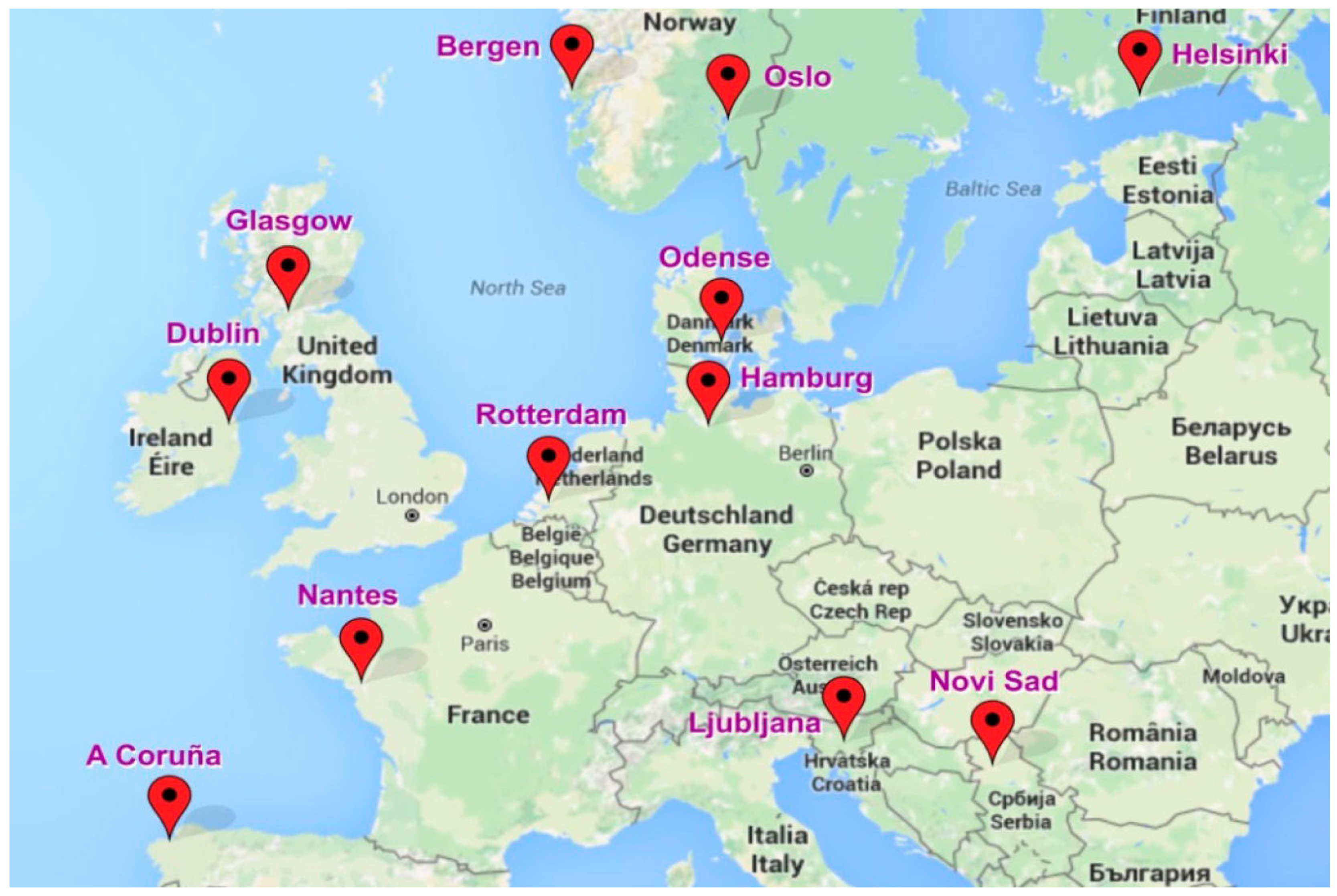
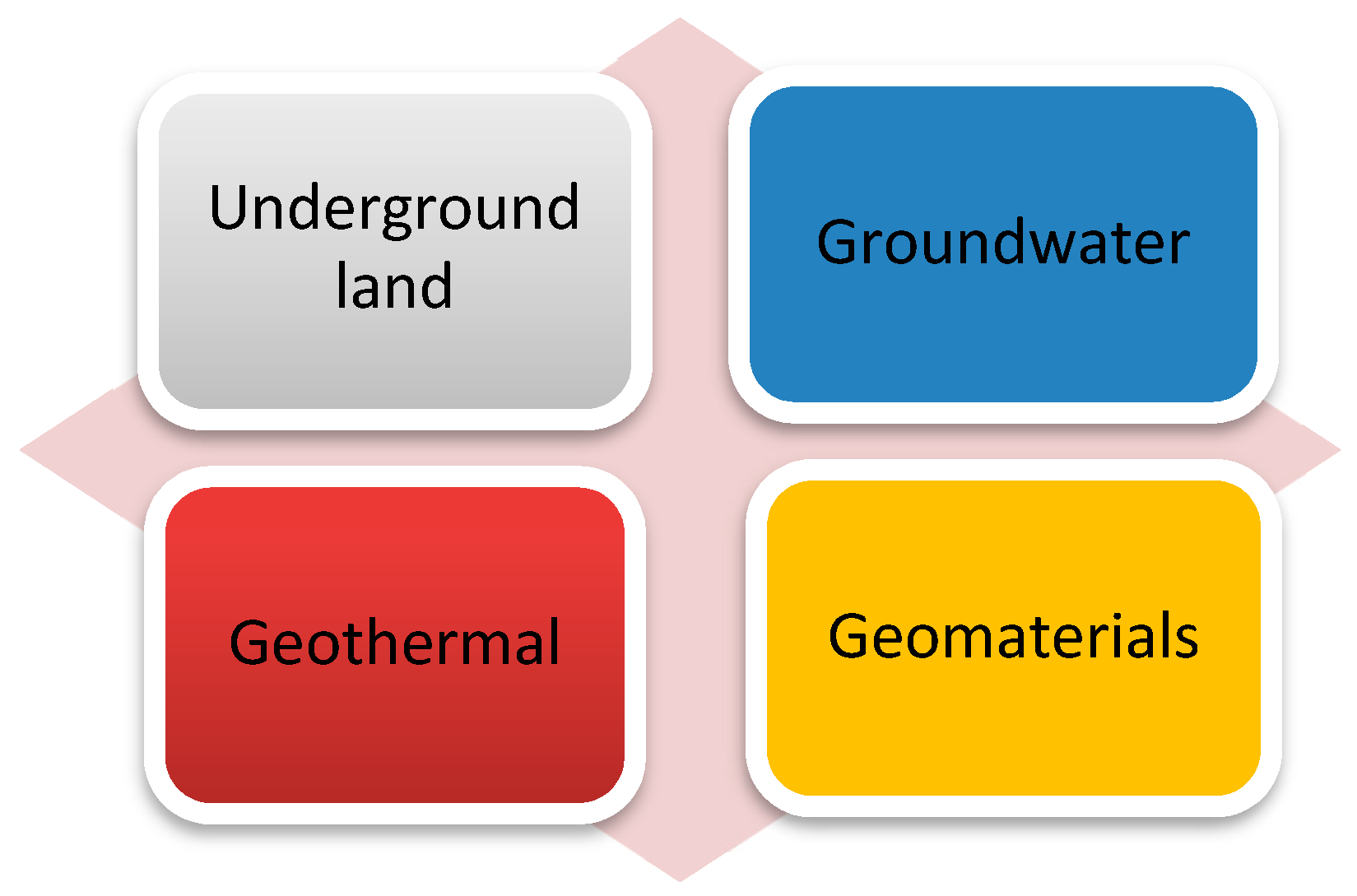
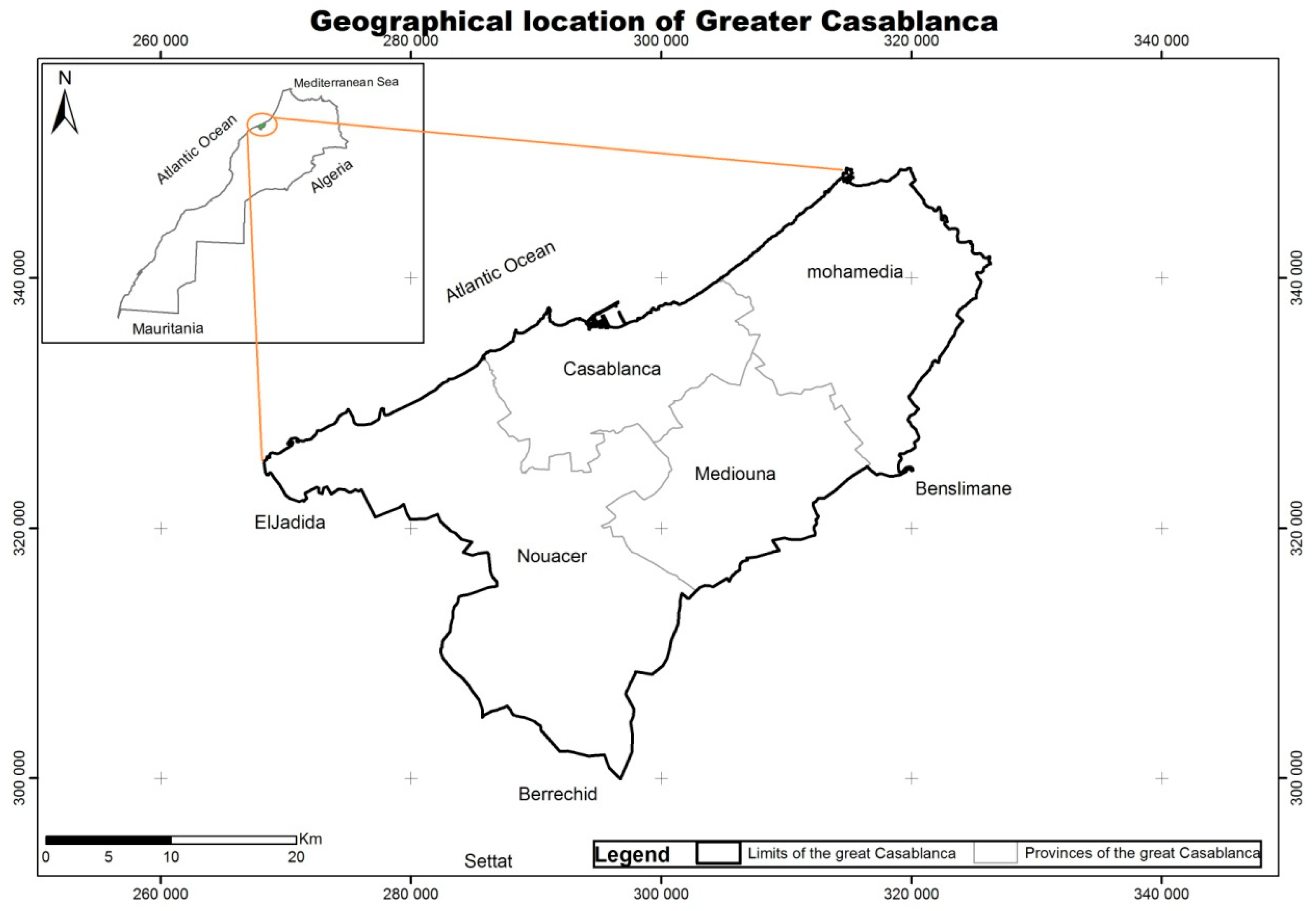
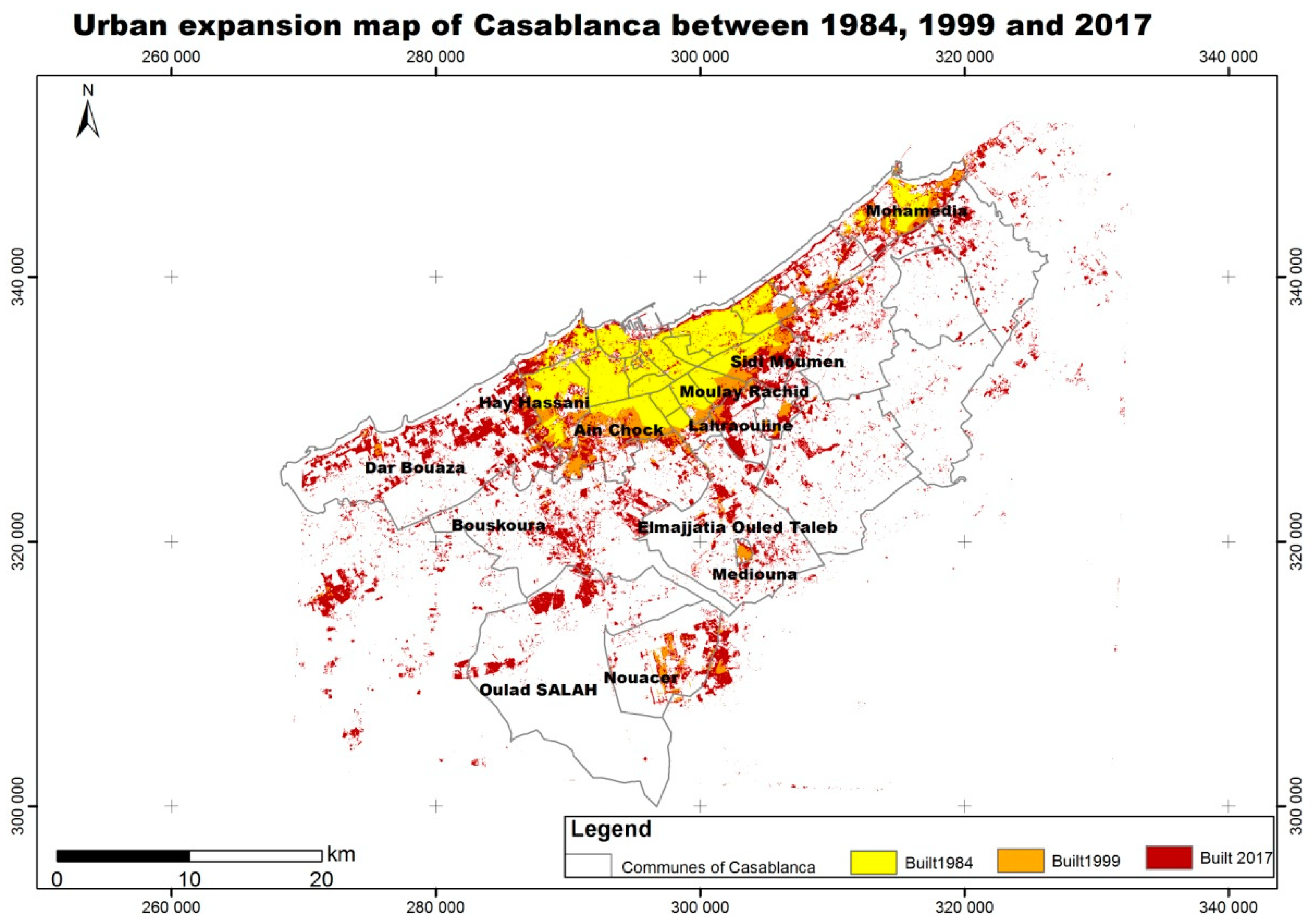
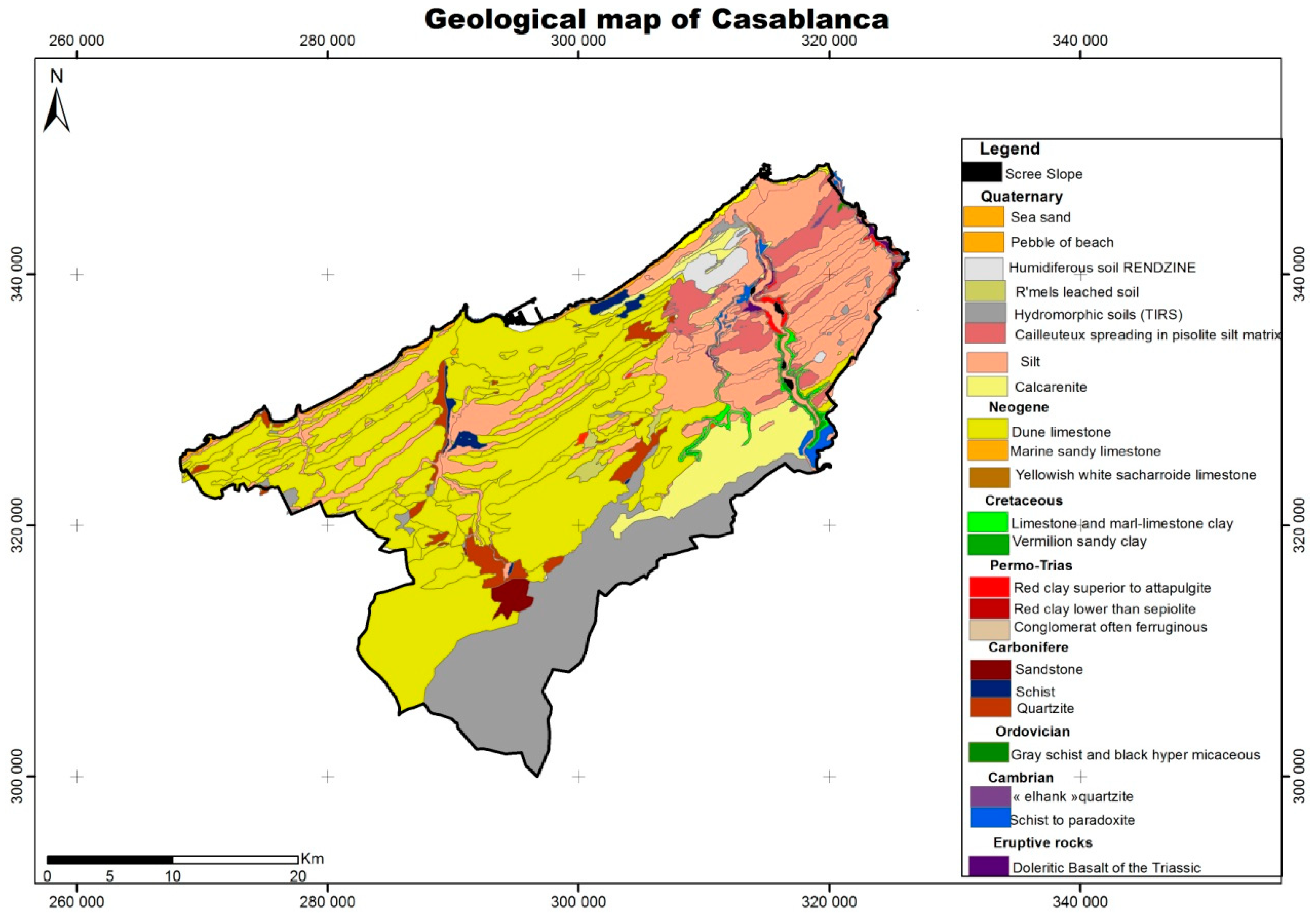
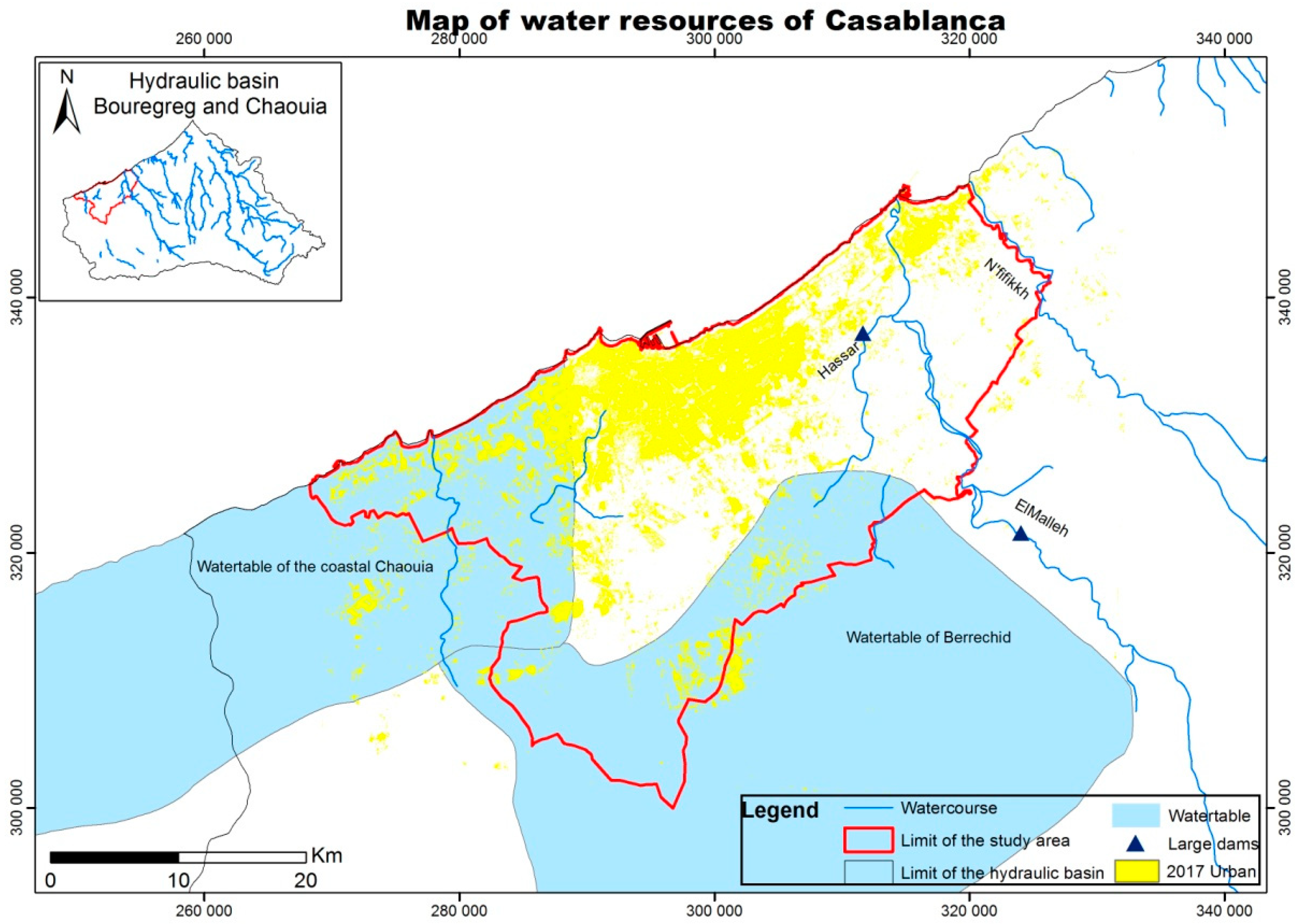
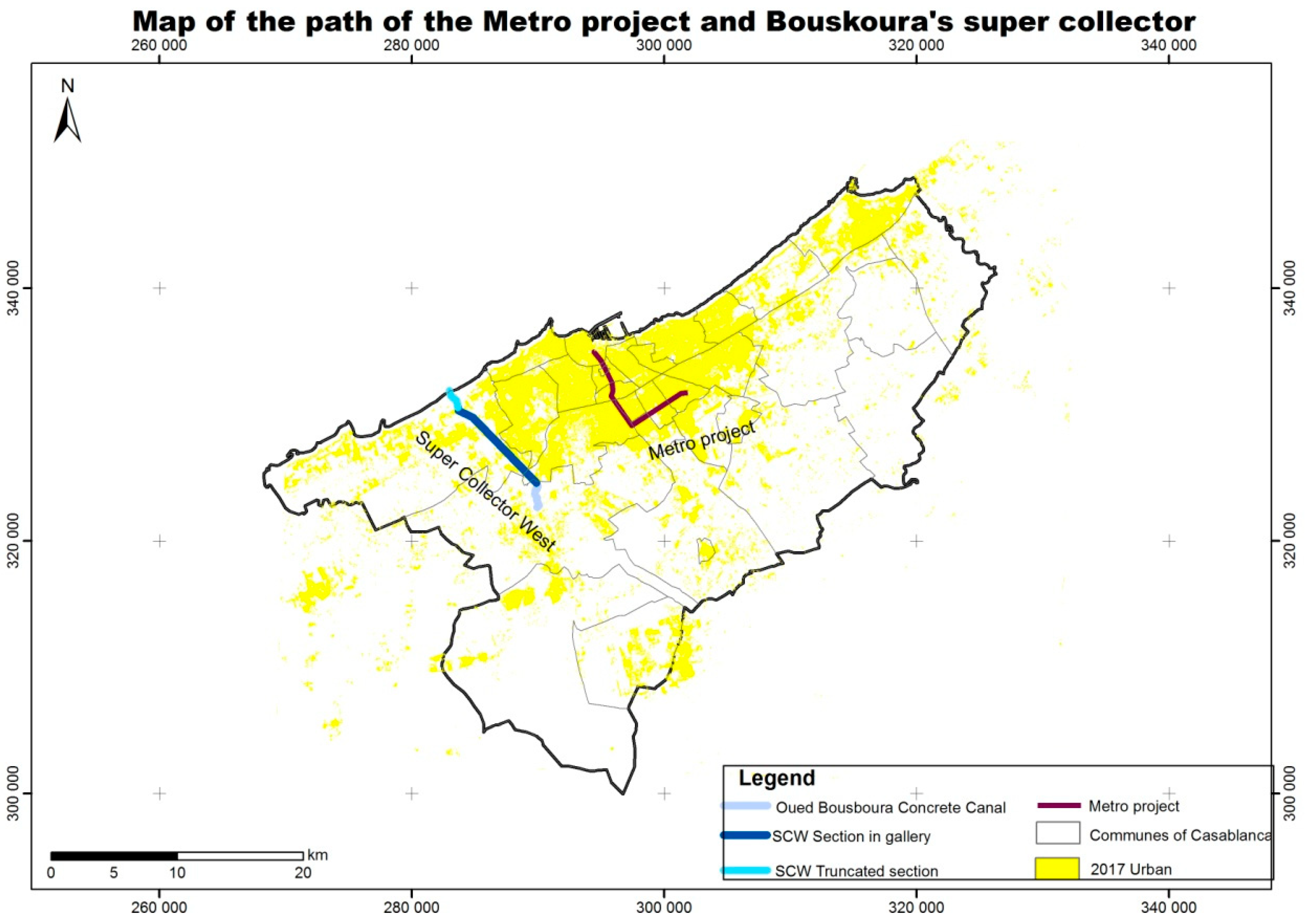

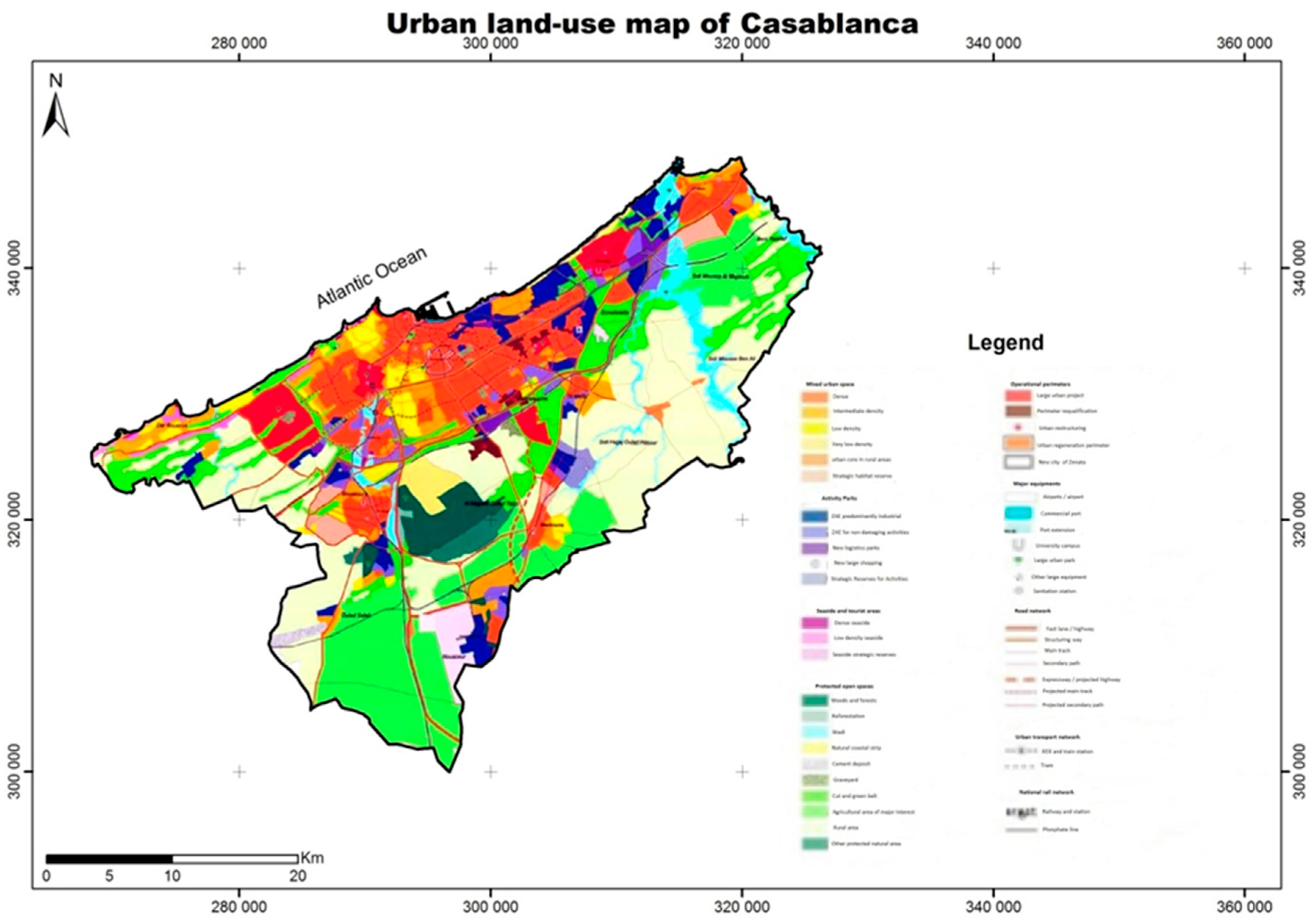
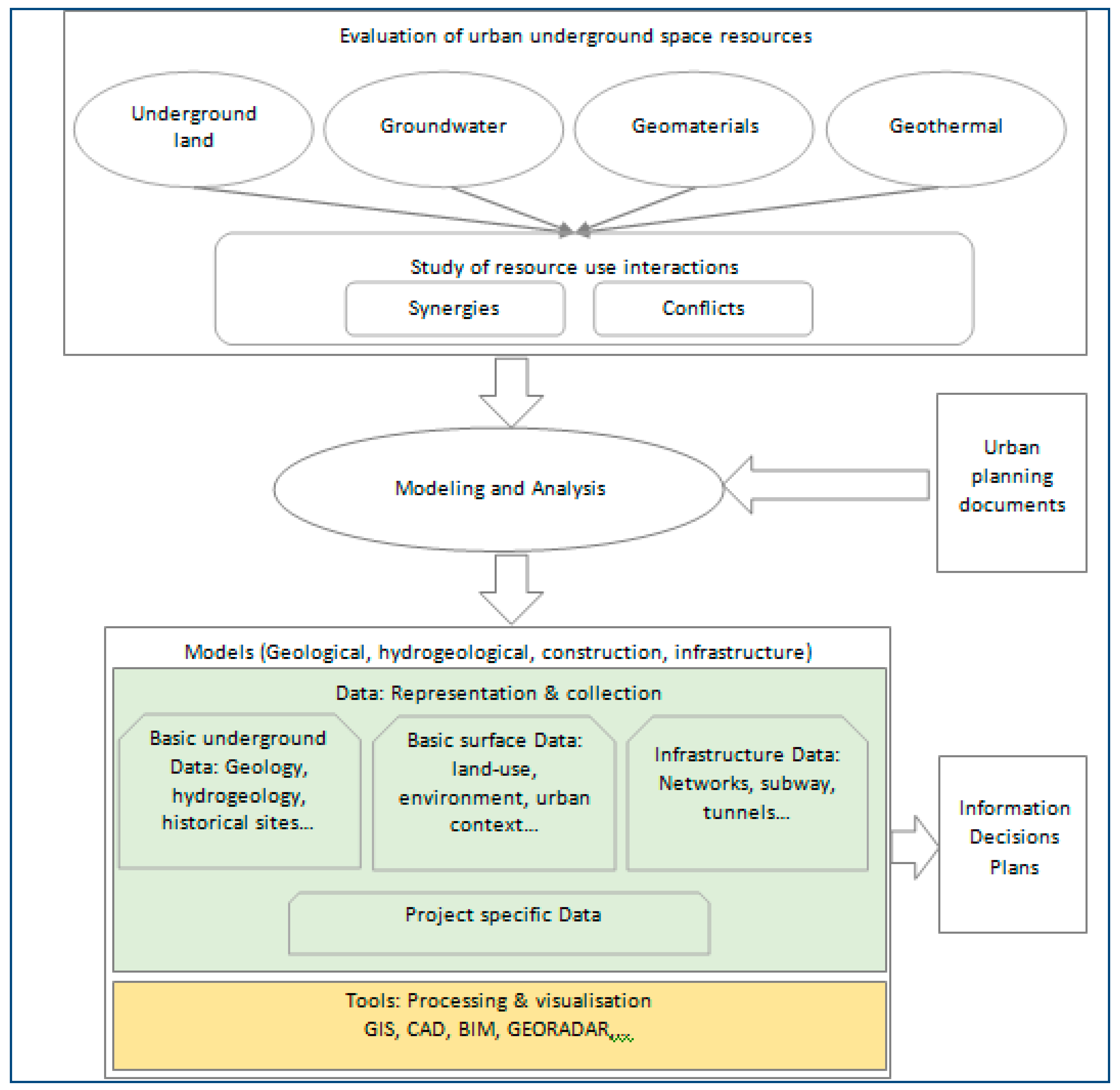
| Initial Surface (sq. km) | Final Surface (sq. km) | Zone of Change (%) | Expansion Speed (%/year) | Expansion Speed (sq. km/year) | |
|---|---|---|---|---|---|
| Between 1984 and 1999 | 107 | 154.63 | 44.51 | 2.96 | 3.15 |
| Between 1999 and 2017 | 154.63 | 287.59 | 85.98 | 4.77 | 7.38 |
© 2018 by the authors. Licensee MDPI, Basel, Switzerland. This article is an open access article distributed under the terms and conditions of the Creative Commons Attribution (CC BY) license (http://creativecommons.org/licenses/by/4.0/).
Share and Cite
Zerhouny, M.; Fadil, A.; Hakdaoui, M. Underground Space Utilization in the Urban Land-Use Planning of Casablanca (Morocco). Land 2018, 7, 143. https://doi.org/10.3390/land7040143
Zerhouny M, Fadil A, Hakdaoui M. Underground Space Utilization in the Urban Land-Use Planning of Casablanca (Morocco). Land. 2018; 7(4):143. https://doi.org/10.3390/land7040143
Chicago/Turabian StyleZerhouny, Mariama, Abdelhamid Fadil, and Mustapha Hakdaoui. 2018. "Underground Space Utilization in the Urban Land-Use Planning of Casablanca (Morocco)" Land 7, no. 4: 143. https://doi.org/10.3390/land7040143
APA StyleZerhouny, M., Fadil, A., & Hakdaoui, M. (2018). Underground Space Utilization in the Urban Land-Use Planning of Casablanca (Morocco). Land, 7(4), 143. https://doi.org/10.3390/land7040143




